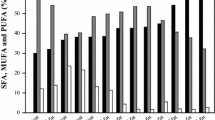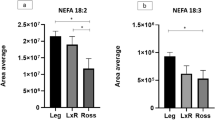Abstract
We compared the composition and content of fatty acids (FAs) in the liver, muscles, and subcutaneous fat of Yakut horses inhabiting extreme environment in the Cryolithozone. Essential linoleic and alpha-linolenic acids, supplied to horses with their food, were accumulated in different tissues. Linoleic acid was accumulated in the liver but alpha-linolenic acid was accumulated in muscle and subcutaneous fat. Such a distribution indicates different roles of these fatty acids in the metabolism of horses. Yakut horse meat is a valuable dietary product owing to its fatty acid composition and content.
Similar content being viewed by others
Avoid common mistakes on your manuscript.
Horses have long been used by humans not only as draft animals but also as a food source. According to FAO, the share of Russia in the world horse meat production in 2013 was 7% [1]. In the Republic of Sakha (Yakutia), the basis of the local residents’ diet is horses of the Yakut breed, which presumably appeared on this territory several centuries ago, migrating with the Yakut people [2]. Horses of the Yakut breed, living under extreme temperature conditions of the permafrost zone, are a vivid example of rapid adaptation of animals to environmental conditions [2]. The causes for such a good adaptation are not fully understood. It is assumed that feeding on cryo-feed, cold-hardened aftergrass enriched in nutrients, helps the animals to survive extremely cold winters [2]. Horses efficiently assimilate polyunsaturated fatty acids (PUFAs), such as linoleic (LA, 18:2n-6) and alpha-linolenic (ALA, 18:3n-3), from plant foods due to the structure of their gastrointestinal tract, the action of microorganisms, and the presence of specific pancreatic lipase-related protein 2 (PLRP2) [1]. These lipases are absent in ruminants, pigs, and turkeys, which are characterized by a low content of PUFAs in tissues [3]. Presumably, microorganisms and/or lipases hydrolyze galactolipids in chloroplasts, which ensures a high efficiency of assimilation of plant PUFAs by horses [1]. Thus, horse meat is considered the most useful dietary product, a source of essential PUFAs (18:2n-6 and 18:3n-3) [4–6], and can potentially be enriched in physiologically valuable long-chain omega-3 PUFAs (20:5n-3 and 22:6n-3).
The aim of this work was to compare the composition and content of fatty acids (FAs) in the liver, muscles, and adipose tissue of horses of the Yakut breed, inhabiting regions with extremely low winter temperatures. The tissues of five individuals were examined—three females aged 7, 8, and 18 months and two males aged 8 months, which were slaughtered by the local population during the mass slaughter of the Yakut horse (November) in Verkhoyanskii, Megino-Kangalassii, Churapchinskii, Olekminskii, and Suntarskii districts of Yakutia. The diet of horses included primarily cereals and sedges. Muscle and adipose tissues were selected from the costal part of the animals. The further procedure of weighing, determining moisture, fixing, and analyzing the composition of FAs was described in detail in [7].
In all samples, 53 FAs were identified. In further analysis, we used 21 FAs whose level was >0.2% (Table 1). In the muscle and adipose tissues of horses, more than 70% of all FAs was represented by 18:1n-9, 16:0, 18:3n-3, and 18:2n-6 FAs; in the liver, 18:2n-6, 18:0, 16:0, and 18:1n-9 FAs predominated (Table 1). In the composition of FAs, no trans-FAs were found, and the content of branched FAs was less than 1% of the total FAs.
The liver of the studied animals differed from the muscle and adipose tissues in the content of the majority of FAs. For example, in the liver, the percentage of 17:0, 18:0, 18:2n-6, and 20:3n-6 FAs was significantly higher whereas the percentage of 14:0, 15:0, 16:0, 16:1n-9, 16:1n-7, 18:1n-9, and 18:3n-3 was significantly lower than that in the muscle and adipose tissues of horses (Table 1).
The percentage of many FAs was similar in the muscle and adipose tissues of horses. However, a distinctive feature of the adipose tissue was the highest content of 18:3n-3 and short-chain saturated FAs (10:0, 12:0, and 14:0) and the absence of the majority of long-chain PUFAs, including the physiologically valuable arachidonic (AA, 20:4n-6), eicosapentaenoic (EPA, 20:5n-3), and docosahexaenoic (DHA, 22:6n-3) acids (Table 1).
The total absolute content (mg/g wet weight) of FAs in the adipose tissue was 20 times greater than in the muscle tissue and in the liver (Table 1).
Two essential PUFAs (LA and ALA) were distributed differently in the tissues of the horses studied. Linoleic acid accumulated primarily in the liver, whereas ALA accumulated in the adipose tissue. We assume that LA is used as a precursor in the synthesis of physiologically valuable AA, the content of which was also the highest in the liver (Table 1). The accumulation of ALA in the adipose tissue indicates the energetic function of this FA (Table 1, Fig. 1). A similar feature was found when the distribution of LA and ALA in different classes of lipids of Iberian horses was studied [8]. Linoleic acid accumulated in polar lipids, obviously performing a building function, whereas alpha-linolenic acid, on the contrary, accumulated in the storage lipids [8].
Average content (mg/100 g wet weight) of the sum of eicosapentaenoic and docosahexaenoic acids (open histograms) and the n-6/n-3 ratio (filled histograms) in the liver, muscle, and adipose tissues of horses of the Yakut breed (for explanations, see the text). The values indicated by the same letters did not differ significantly at p < 0.05 after Tukey’s HSD post hoc test.
The composition of PUFAs in muscle and adipose tissues of horses depends on the composition of PUFAs in food. For example, the content of 18:2n-6 and 18:3n-3, the main polyenes of horse tissue, varies greatly depending on the diet (12–35.1 and 0.75–24.3%, respectively) [1]. Both high and low values of PUFAs were found in horses living in mild climate. Horses of the Yakut breed, feeding on aftergrass, which underwent cold hardening and has a high content of 18:3n-3 (~60%) and 18:2n-6 (~12%), are rich in these polyenes. However, it remains unclear whether these PUFAs play an important role in the adaptation of horses to the extremely cold climate.
The percentage of the physiologically valuable omega-3 PUFAs (namely, EPA and DHA) in the muscle tissue and liver of horses was insignificant and constituted 0.4% of the sum of all FAs, despite the high percentage of the precursor of these FAs, 18:3n-3 (Table 1). The absolute content (mg/g wet weight) of EPA and DHA, as well as the ratio of PUFAs of the omega-6 and omega-3 (n-6/n-3) families, are used to evaluate the nutritional value of products [7]. The liver and muscle tissue did not differ in the absolute content of EPA and DHA; however, the n-6/n-3 ratio was dietarily more favorable in the muscle tissue. That is, out of the three tissue types studied, the muscle tissue is a more valuable product in terms of the content of omega-3 PUFAs.
Thus, the relative and absolute content of FAs of horses of the Yakut breed was studied for the first time. A high content of linoleic and alpha-linolenic acids was found in all tissues analyzed. We assume that linoleic acid is partially used as a precursor in the synthesis of physiologically valuable arachidonic acid, whereas alpha-linolenic acid performs mainly an energetic function. Horse meat (muscle tissue) is a valuable dietary product due to the low ratio of n-6/n-3 PUFAs (<1).
REFERENCES
Belaunzaran, X., Bessa, R.J.B., Lavín, P., et al., Meat Sci., 2015, vol. 108, pp. 74–81.
Petrov K.A., Perk A.A., Chepalov V.A., et al., S.-Kh.Biol., 2017, vol. 52, pp. 1129–1138.
De Caro, J., Eydoux, C., Chérif, S., et al., Comp. Biochem. Physiol., 2008, vol. 150, pp. 1–9.
Juárez, M., Polvillo, O., Gómez, M.D., et al., Meat Sci., 2009, vol. 83, pp. 224–228.
Guil-Guerrero, J.L., Rincón -Cervera, M.A., Venegas-Venegas, C.E., et al., Int. Food Res. J., 2013, vol. 20, pp. 3249–3258.
Belaunzaran, X., Lavín, P., Barron, L.J.R., et al., Meat Sci., 2017, vol. 124, pp. 39–47.
Gladyshev, M.I., Makhutova, O.N., Gubanenko, G.A., et al., Eur. J. Lipid Sci. Technol., 2015, vol. 117, pp. 1417–1421.
Belaunzaran, X., Lavín, P., Mantecón, A.R., et al., Animal, 2018, vol. 12, pp. 417–425.
Funding
This study was supported by the state assignment within the framework of the Basic Research Program of the Russian Federation (topic no. 51.1.1) and the state assignment of the Ministry of Science and Higher Education of the Russian Federation to Siberian Federal University in 2020 (Project no. FSRZ-2020-0006 “Biologically active substances in environmental, biotechnological and medical systems”).
Author information
Authors and Affiliations
Corresponding author
Ethics declarations
The authors declare that they have no conflict of interest. This article does not contain any studies involving animals or human participants performed by any of the authors.
Additional information
Translated by M. Batrukova
Rights and permissions
About this article
Cite this article
Petrov, K.A., Makhutova, O.N. & Gladyshev, M.I. Fatty Acid Composition of Yakut Horse Tissues. Dokl Biochem Biophys 492, 105–107 (2020). https://doi.org/10.1134/S1607672920030047
Received:
Revised:
Accepted:
Published:
Issue Date:
DOI: https://doi.org/10.1134/S1607672920030047





